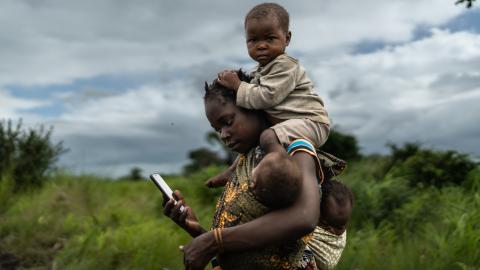Using SMS platforms to support Family MUAC in Kenya
This is a summary of the following paper: Tickell K, Achieng C, Masheti M et al. (2023) Family MUAC supported by a two-way SMS platform for identifying children with wasting: The Mama Aweza randomised controlled trial. The Lancet, 64. https://www.sciencedirect.com/science/article/pii/S2589537023003954
This randomised controlled trial investigated the ‘Manually Administered Malnutrition Monitoring System’ (MAMMS) - a Family Mid-Upper Arm Circumference (MUAC) approach supported by a two-way SMS messaging platform - to determine whether this intervention affected time-to-diagnosis (wasting), the severity of illness, and the duration of treatment in children. Eligible participants were children aged 5-12 months with MUAC of 12.5-14.0cm. Children with MUAC <12.5cm and/or nutritional oedema were referred to nutritional services for treatment. The study period was between 1 August 2019 and 31 January 2022 and follow-up measurements were taken at six months.
The MAMMS group (n=599) received weekly automated texts, which included a validated, locally tailored health education message and a reminder to measure their child’s MUAC and send the result via SMS. Community health workers and nutritionists then reviewed these messages and requested any children with moderate or severe wasting to be taken to a clinic for treatment. The control group (n=601) received standard care based on existing "gold standard" community-based management of acute malnutrition treatment, with active and passive case finding, to ensure the MAMMS group was compared with a strong community screening programme.
Wasting incidence over six months was 37% lower in the intervention group (HR 0.63, p=0.02). For those who became wasted, the median number of days-to-diagnosis was comparable between intervention and control groups, at 63 and 58 days respectively. Average treatment coverage was different between intervention (83.3%) and control (55.6%) groups, but not significantly so (p=0.30) due to large, overlapping confidence intervals (95% CI 39.9-100 and 22.3-88.9, respectively). Mean MUAC at diagnosis and mean treatment duration were comparable between groups.
Anthropometric measurements were taken independently by researchers and caregivers to validate these measurements. This increases our confidence in the accuracy of these outcome variables, especially as all caregivers successfully passed this validation process. Caregivers were excluded from the study if they planned to move from the study area or if their child was acutely unwell and required hospitalisation. These are practical considerations, but it is plausible that children from those mothers had a particularly high risk of wasting and were not captured in this study. Dropout rates were broadly comparable for both study groups (â10%), as were the various baseline health and demographic characteristics of each group, increasing the validity of this study.
Although this study occurred in a high-literacy, agriculturally productive Kenyan setting - which makes it hard to generalise these findings - the results of this trial show a clear benefit of the MAMMS intervention on wasting incidence. The study employs a robust methodology and there is a plausible mechanism for its success. Findings suggest that Family MUAC supported by two-way SMS offers an alternative or addition to door-to-door active screening as well as a potential method to reduce the risk of moderate wasting.
For more information, please contact Kirk Tickell at kirkbt@uw.edu


